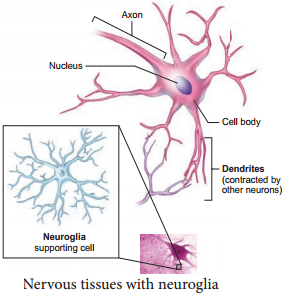Learninsta presents the core concepts of Biology with high-quality research papers and topical review articles.
Neural Tissue Definition and its Uses
Nervous tissue exerts the greatest control over the body’s responsiveness to changing conditions. Neurons, the unit of neural system are excitable cells (Figure 3.8).

The neuroglial cells which constitute the rest of the neural system protect and support the neurons. Neuroglia makes up more than one-half of the volume of neural tissue in our body. When a neuron is suitably stimulated, an electrical disturbance is generated which swifty travels along its plasma membrane. Arrival of the disturbance at the neuron’s endings, or output zone, triggers events that may cause stimulation or inhibition of adjacent neurons and other cells (You will study in detail in Chapter 10)
Neurons, or nerves, transmit electrical impulses, while neuroglia do not; neuroglia have many other functions including supporting and protecting neurons.
Integration and communication are the two major functions of nervous tissue. Nervous tissue contains two categories of cells – neurons and neuroglia. Neurons are highly specialized nerve cells that generate and conduct nerve impulses.
Nervous tissue contains two major cell types, neurons and glial cells. Neurons are the cells responsible for communication through electrical signals.
Nervous tissue is made up of different types of neurons, all of which have an axon. Bundles of axons make up the nerves in the PNS and tracts in the CNS. Functions of the nervous system are sensory input, integration, control of muscles and glands, homeostasis, and mental activity.
The function of muscle tissue (smooth, skeletal, and cardiac) is to contract, while nervous tissue is responsible for communication.
Brain, spinal cord and nerves constitute nervous tissue. Tendon is a fibrous connective tissue connecting bones to muscles. Nervous tissue is absent in tendon. These are made up of collagen.
Neurons, also known as nerve cells, send and receive signals from your brain. While neurons have a lot in common with other types of cells, they’re structurally and functionally unique. Specialized projections called axons allow neurons to transmit electrical and chemical signals to other cells.
Although the nervous system is very complex, there are only two main types of cells in nerve tissue. The actual nerve cell is the neuron. It is the “conducting” cell that transmits impulses and the structural unit of the nervous system. The other type of cell is neuroglia, or glial, cell.